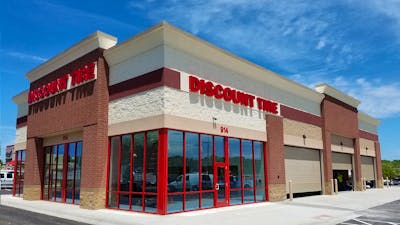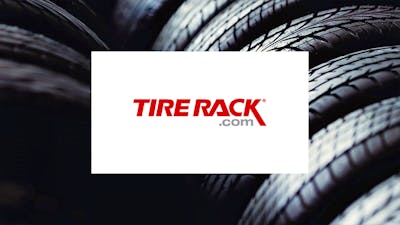Best Tires for the Chevrolet Silverado
There are several reasons to shop for new tires for your Chevy Silverado. Maybe as replacements, maybe to improve on the factory originals, or maybe because you’ve moved to a more rigorous environment with constant winter weather. Whatever the reason, it’s sometimes better to shop a little and see if there are better options than the factory original tires. If you’d prefer to stay with the OEM option, you can jump below to find more information on what came with your truck.
Get the Best Deals on Tires
The reasons for moving to non-OEM tires are substantial. Automakers trend towards striking a balance between fuel economy, performance, and price when creating a relationship between a tire maker and a vehicle model. Those relationships, in fact, can play a big part in the choice too. The best tires for your Silverado may not be the OEM options. Especially if you are not the “average” Chevy driver. Here we will look at the best choices for your Chevrolet Silverado tires, looking at each trim level of the truck as well as budget, mid-grade, and premium tire choices for each.
Have an older Silverado? See tire sizes for previous years.
Best Tires for the Chevrolet Silverado Work Truck and Custom
- Fuzion SUV - Best budget tire
- General Grabber HTS - Best mid-priced tire
- Firestone Destination LE 2 - Best superior tire
Best Tires for the Chevrolet Silverado Custom Trail Boss and LT Trail Boss
- Sumitomo Encounter AT - Best budget tire
- BFGoodrich All-Terrain T/A KO2 - Best mid-priced tire
- Goodyear Wrangler All-Terrain Adventure with Kevlar - Best superior tire
Best Tires for the Chevrolet Silverado LT and RST
- Bridgestone Dueler H/T D684 II - Best budget tire
- Firestone Destination LE 3 - Best mid-priced tire
- Goodyear Wrangler Fortitude HT - Best superior tire
Best Tires for the Chevrolet Silverado LTZ and High Country
- Firestone Destination LE 3 - Best budget tire
- Goodyear Wrangler Fortitude HT - Best mid-priced tire
- Michelin Defender LTX M/S - Best superior tire
Shop Tires Online and Save
Online tire prices are usually less than in store

Original Equipment Chevrolet Silverado Tires
Most Chevrolet Silverado models have 17-inch wheels as standard, though wheel sizes can vary by trim level and options choices. The tire choice for the Silverado changes according to whether the truck is off-road focused (as in the Trail Boss models) or highway comfort-focused (as with all other trims).
- The Chevrolet Silverado Work Truck, Custom, LT, and RST trims come with General Grabber HTS highway/all-season tires as original equipment. These are sized as 255/70R17 112S with blackwalls.
- Silverado Trail Boss models usually include General Grabber APT tires as on/off-road and all-terrain options as factory defaults. (Note: This may change according to region.) These are sized as 255/70R17 112T
For trucks with larger wheels, Chevrolet often upsizes tires from the same manufacturer and product line.
Top Replacement Tire Brands for the Chevrolet Silverado
Continuing our focus on the 17-inch standard tires found on most models of the Silverado, here we are looking at the best tire brands for the truck. When choosing the best tires for your Silveraod, brand can be important. Many brands include warranties, have a better reputation for reliability and good dealings, or are competitively priced. The brands below fall into the same budget categories as our above choices (budget, mid-grade, and premium) and come highly recommended by consumers like you.
- Budget: Bridgestone Dueler series - These well-priced highway/all-season tires are a solid choice for the Silverado. They have a reputation for long tread life and Bridgestone’s 90-day “Buy and Try Guarantee” are high points.
- Mid-Grade: Firestone Destination series - These are moderately-priced options in several grades for various needs. Consumers score the Firestone Destination brand at a 4.5 out of 5 stars. The tires emphasize a quiet ride quality and smooth operation. Consumers are especially happy with tread life for these tires.
- Premium: Goodyear Wrangler series - These tires focus on traction in all conditions, including all-weather and all-terrain. Consumers rate these tires very highly at 4.75 stars. The warranty Goodyear offers is also very good and includes both replacement and exchange.
When Should You Replace Tires?
The two things that affect tires the most are time and mileage. When tires are made, they have a limited lifespan before their compounds may begin to break down or change. The mileage on a tire is a general indication of its wear and usage, similar to how mileage on your Silverado determines its wear and tear.
Neither time nor mileage are perfect indicators of a tire’s usability or service life. Time can be relative if the tire has been stored well or otherwise cared for. Mileage may not indicate what type of usage the tire underwent, with some uses causing more wear than others. These two metrics are just general measurements.
Most tires are made to last about five years under normal storage or use. On the sidewall of every tire made for sale in the United States is a raised date code. This code is part of a 12-digit DOT code that gives other information about the tire as well, including place of manufacture and origin of the compounds used. The DOT code is broken into three sections of four numbers each. The date code is the final four numbers, the first two being the week of the year the tires were made and the last two being the year itself. A date code of 1720 indicates that the tire was manufactured in the 17th week of 2020, or April 20-26, 2020. A date code of 3019 would indicate the 30th week of 2019 (July 22-28, 2019).
Mileage is another indicator of a tire’s lifespan. Expected mileage is determined by the manufacturer and indicated by a mileage code that is usually included with the tire’s sizing information. The Uniform Tire Quality Grade (UTQG) rating is the industry standard for tire grading for mileage expectations. The UTQG assumes average temperatures and usages for the tire and is based on a baseline durability rating for each tire type. Most tires will have their UTQG rating on their sales information and many have it embossed in the tire itself, usually near the sizing information.
A tire rated at 100 has a standard wear rating with ratings going up, usually in increments of 100, after that. The rating number can be multiplied by 100 to get an average mileage expectation for the tire. Thus a Chevrolet Silverado tire with a UTQG rating of 500 has a 50,000-mile average lifespan expectation. Given that these numbers are very relative and highly dependent on actual usage scenarios, the expected lifespan numbers should be taken as a possibility, not a hard-and-fast rule.
Most mileage expectation ratings will be followed by a traction rating. This will be two alphabetic letters. The first indicates how well the tire stops in wet conditions (e.g. rain). This will be an A, B, or C. Each indicates worsening traction. So a tire rated as B has an average stopping traction in wet conditions whereas an A has the best. The next letter is a temperature rating, again with A being the highest tolerance for extreme heat and C being the worst. Thus a tire rated as AB has good wet pavement stopping and average temperature tolerance.
Most buyers of tires for their truck will consider the best Chevrolet Silverado tire replacement timing to be when the tread life or age of the tires is becoming a concern. Most tire shops and professionals can quickly assess tires to determine replacement.
Why Not Replace with Original Equipment Tires?
The reasons for going with tires that are not OEM can be many. Sticking with the OEM tires means that the Silverado owner knows that what Chevrolet planned for the truck and expected from it will always be there for that owner. Yet the OEM tires may not be optimal for the intended use that the Silverado owner actually has for the truck.
Chevrolet Silverado models which tow, haul, or go off-pavement (but not necessarily off-road) may be better with tires different from the manufacturer’s originals. Silverado models that spend all of their time on the highway are also likely to benefit from different tire choices from the OEM choice.
Tire choice can affect ride quality, fuel economy, cost of ownership, safety, and many other things during the life of your Silverado. Choosing the wrong tires can become a cost or liability. Perhaps all-weather considerations, winter tire swap-outs, or an intention to haul heavy cargo regularly are considerations that change your choice of tire. All-terrain tire preferences, for example, may dictate mounting winter tires during the coldest months in order to both save tread on expensive A/T tires and improve safety during the winter.
The reasons for choosing non-OEM replacements can be many.
Changing Chevrolet Silverado Tire Sizes
The Silverado was designed to have a specific circumference of tire and wheel in order to maintain the truck’s height and clearance profiles. In order to maintain that, the factory defaults are used as a baseline for changing wheel or tire sizes for the truck. Tire sizes are determined by a height of the sidewall that is determined as part of the width of the track (see below for details). The height of the sidewall affects the ride height of the truck and must be in concert with the wheel the tire is mounted on.
This is why when changing tire sizes, it’s important to change wheel sizes to match. For example, adding a larger wheel to change the look of your Silverado should coincide with changing the tire size to a shorter sidewall in order to maintain the height and clearance ratio of the truck. Further, keeping the same overall circumference of wheel and tire keeps the truck’s sensors and speedometer in sync, avoiding expensive reprogramming. It also maintains the truck’s safety profile, load height, and trailer hitch height. Also important considerations with a Silverado.
How To Read Tire Sizes
Reading tire sizes is fairly easy once the numbers are understood. Tire sizes are listed in three number sets combined together plus another number indicating the tire’s rating. The standard Chevrolet Silverado tire size is 255/70R17 112S. Lets break that down to find out what each section of numbers and letters means:
- The 255 - is the width of the tire’s tread in millimeters. So this tire is 255mm wide at its tread.
- The 70 - is a percentage of the tire’s tread width and indicates the height of the sidewall. In this case, the height of the sidewall is 70 percent of the tire’s tread width, or 178.5mm.
- The R - indicates that these are radial tires. Radials are the most common type of tire today. They have fabric woven as a structure for the rubber compounds which strengthens the tire during spin. Radials radiate out from the center of the tire to spin from the radius of the tire’s circle. This helps spread the load at the point of contact with the road and resist puncture.
- The 17 - indicates the tire’s opening size or what size of wheel the tire is meant to be mounted on. In this case a 17-inch wheel.
- The 112 - is the tire’s load rating, which is a function of how much weight the tire itself can sustain on its contact point without risk of deflation or blowout.
- The S - is the speed rating for the tire. Speed ratings are the maximum speed to which the tire is rated to run without risk of blowout or over-inflation from heat. Most automotive tires are rated between 87 and 120 miles per hour. The S in this case indicates a speed rating of 112 mph.
Tire Sizes By Year
| Year | Trim Type | Tire Size |
|---|
Shop Tires Online and Save
Online tire prices are usually less than in store

FAQ
- What is the best Chevrolet Silverado tire pressure?
Inside the driver’s side door frame is a white and yellow label which indicates tire sizes, pressures, and other information for your truck. These are the factory settings and even aftermarket replacement tires usually conform to these numbers. Tire pressures will be indicated in both “cold” and “hot” numbers (usually 32 and 35 psi respectively). Note that the tire pressure listed on the tires themselves is their MAXIMUM tire inflation pressure, not their optimal pressure.
- How often should I rotate tires on my Silverado?
Most tire manufacturers will give a rotation interval for their tires. The OEM tire rotation interval for the Chevrolet Silverado is 7,000 miles (roughly twice a year). It’s important to the life and wear of your tires that rotations happen regularly.
- What is the best tire change kit for a Chevrolet Silverado?
Every Silverado sold comes with a tire change kit as part of its basic equipment. This is typically stored behind the rear seats, under the front passenger’s seat, or under the rear seats, depending on the cab size and configuration of your Silverado. The kit includes a basic screw jack, a lug wrench to fit your factory lug nuts, and parts that assemble into a long rod to lower the spare tire from underneath the cargo bed. It’s recommended that Silverado owners consider upgrading their basic kit to include emergency markers, jumper cables, and a more heavy-duty jack.













